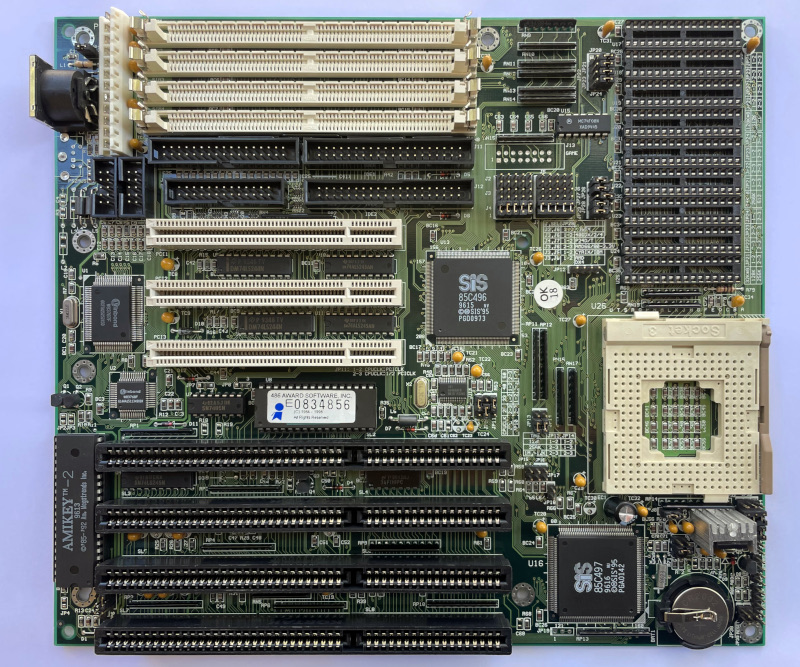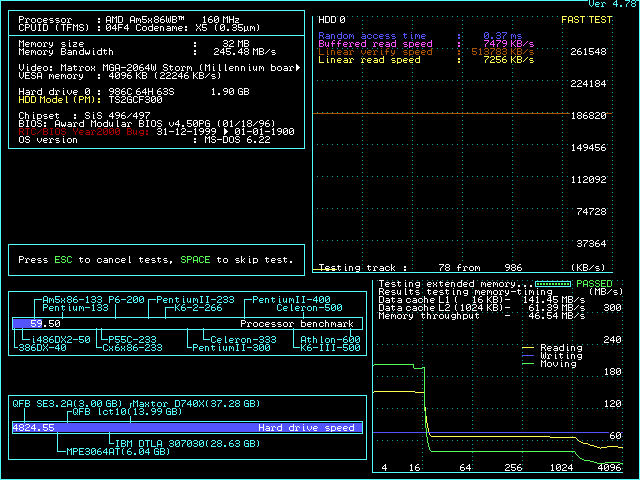Reply 1560 of 2374, by WJG6260
- Rank
- Member
Seems like now's the perfect time to pop back into this conversation!
@feipoa and @pshipkov
All numbers pshipkov shared are mine from a few pages ago.
I tested everything on a Nice/Lion SuperEISA with the following configuration:
- BIOS version 1.21 was on the board at all points throughout testing
- All BIOS timings were tightest/most optimized
- A 40MHz DIP-14 crystal oscillator was used for clock generation
- I/O recovery was changed from 3 (lowest) to 11 (highest) for the Trio32 and Trio64 w/ N9 BIOS
- 64MB of 60ns parity 30-pin DRAM was used for all testing
- an Am5x86 ADZ was used for all testing at 160MHz
- L1 cache was in WT mode due to chipset limitations
- L2 cache was in WB mode (1024k on all tests)
Importantly, this board is pretty primitive. The chipset is from 1992, and the VLB implementation is not the best, relative to that of, say, an SiS471-based board. By this, I mean to say that the board cannot adjust between Synchronize/Transparent or T2/T3 with respect to VLB settings and timings. I have found that there are erroneous/strange results in testing that do not equivocate with those from other boards, for example, the S3 Vision868 widens the gap between itself and the Trio64 on my SiS471-based MTech R407e, providing WinTune2 scores in the ~14.7 kPixels/s range, as compared to the Trio64's ~12.9 kPixels/s score. Again, odd, but notable, is that the Mach64 is pretty much 1-for-1 outperforming the Mach32 on the SiS471-based b0ard, but on the SuperEISA, this is not the case. I posit this is due in part to an "incompatibility" with the board, after having scoured usenet archives and noting comments about lousy EISA configurations with the Mach64 and other such issues. The ARK1000VL is also not that much faster than its peers on the SuperEISA, if at all. On the SiS471-based board and even on OPTi895-based boards, this is not the case, as has been touted numerous times on Vogons.
On the SuperEISA, and probably due to the reasons above--namely, the SiS406/411 chipset--it seems that DOOM hits a hard wall at around ~57.7fps. This is not the case with the SiS471-board aforementioned. It becomes clear upon seeing some numbers that the faster VLB cards are in some way hindered by the VLB implementation of the SiS406/411 or that of the SuperEISA itself. On the MTech SiS471 board, I saw the Vision868 pull marginally ahead of the Trio64 in most regards, besting it in DOOM at 63.1 fps to 62.9 fps. A Mach64 Graphics Pro Turbo w/ 4MB VRAM pulled 55.2 fps, same as the older Mach32 w/ 2MB VRAM. The ARK1000VL there posted 68.0 fps, for reference.
I actually have a Diamond S3 968 VLB. It is in pieces.
It had bad memory modules, and in my haste to repair it, I lifted a few pads. I need to have someone else take a look at this because I am clearly incapable of fixing it properly myself. I would like to add that and see where things fall; clearly the Diamond 868 exceeds expectations, and that makes sense, given its VGA core's usage in the Trio64V+ and the overall slightly faster performance of said Trio64V+ vs the standard Trio64.
It's interesting your SPEA replica is faster. Have you ever tried swapping the BIOSes on your 968s and re-running the results?
I have noted that the 964 was slower than its siblings in DOS. The whole DRAM/VRAM speed difference thing doesn't seem to show truth in my testing, at least with both the ATi Mach32 Graphics Ultra Pro (VRAM) and Graphics Ultra Plus (same card but DRAM), the latter of which was supposed to be marginally faster as per PC Mag. I found this to be the case only in DOOM at 0.1 fps, so I consider the whole thing a wash. I think the S3 928 might be a better candidate for testing, but I only have an EISA/ISA version, and no DRAM counterpart.
I'm still waiting on a miracle to find a Trio64V+ on VLB to add to the roundup of the S3 Vision/Trio family. That would be interesting.
Like @pshipkov suggested, I will be re-testing the 864 with a Diamond BIOS, although I suspect not much will improve from the Paradise BIOS and its aggressive timings. I would be happily proven wrong though; that Paradise card has 60ns EDO modules on it. That could get interesting, given the Trio64 and 868 only have 70ns modules. Same with the 964.
If you want to see a few results laid out with the Trio64, ARK, and Vision cards, here's what I've got:
ARK1000VL (1ws enabled)Wolf3D: 123.6 fpsPC Player: 26.8 (10.3 fps @ 640x480)Doom: 57.7 fpsQuake 1: 17.9 fpsWinTune 2: 7634 KPixels/secondMiroCrystal 20SV (S3 Vision964 w/ Diamond Stealth64 VRAM H BIOS)Wolf3D: 114.5 fpsPC Player: 26.2 fps (10.1 fps @ 640x480)Doom: 56.0 fpsQuake 1: 17.7 fpsWinTune 2: 13525 KPixels/secondS3 Trio64 (Stealth64 v2.02)Wolf3D: 120.3 fpsPC Player: 26.7 fps (9.7 fps @ 640x480)Doom: 57.0 fpsQuake 1: 17.9 fpsWinTune 2: 12495 KPixels/secondDiamond Stealth 64 DRAM (S3 Vision868) (Diamdond Stealth Video v1.01 BIOS)Wolf3D: 122.1 fpsPC Player: 26.8 fps (9.8 fps @ 640x480)Doom: 57.1 fpsQuake 1: 17.9 fpsWinTune 2: 13347 KPixels/secondParadise Bahamas 64 (S3 Vision864)Wolf3D: 121.8fpsPC Player: 26.8 fps (9.7 fps @ 640x480)Doom: 57.0 fpsQuake 1: 17.9 fpsWinTune 2: 11955 KPixels/second
----
@pshipkov
Really liking that PIO-3. I now see why it was loved by RedHill computers.
Voodoo 3 support is a nice surprise.
As for the flat curve in SpeedSys--I have noticed this more predominantly on Intel chipsets and with Intel CPUs. The Pentium shows the same on many 430xx boards, as does the Intel DX2/DX4 on 486 boards. I am curious if this is a glitch in SpeedSys, or if there's more to things here. Seems like 180MHz doesn't do too much on this board. Is this due to the relaxed timings or wait states for chipset I/O?
Seems like a middle-of-the-road board for the POD100. Not too bad, but definitely versatile.
Interesting that this board is so much better than the VIP-IO-2, based on the same chipset. Strange stuff.
VLB bridging on that board must really kill performance.
Either way, happy to read that this was trouble-free. Seems like a really nice assembly.
Do you know if PCI is bridged on this board? It seems to be pretty fast, but the -505 part is *I think* a bridge.
FIC made good stuff. The PA-2007 is easily my favorite Socket 7 board of all time.
The VA-502 is also quite good.
Same with the VIP-IO if you don't care about performance and just want a DX2/4 with PCI/VLB. It works with many cards without hassle.
Weird but interesting fact for prosperity: FIC is/was part of-or related to-Formosa Plastics. I believe VIA at one point was too.
Hence, when Intel sued VIA for the controversy surrounding their P4 chipset that resulted from reverse-engineering the P4's bus, they actually sued FIC as well for distributing such boards. Weird stuff.
Also, regarding the M919.
Never owned one and probably won't get one unless it's like @feipoa said, ~$20 would be my cap personally.
I think I've seen enough about it from your guys' tests.
That being said, it's an alright board overall.
I do think it's worth mentioning that the recent price spikes are probably due in part to a certain YouTuber many of us know.
His Quantex 486 has that board, and he made a few "blerbs" about it. He even made one about the replacement cache sticks.
Neat boards, in the sense that they're just so strange.
But nothing strange enough for me and my weird tastes, I guess 🤣

